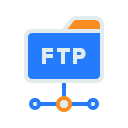Comparing Backblaze B2 and Wasabi: Which Cloud Storage Solution Fits Your Needs?
Explore an in-depth comparison between Backblaze B2 and Wasabi cloud storage services, focusing on their features, pricing, and performance to help you determine the best fit for your requirements.
Introduction
In the evolving landscape of cloud storage, Backblaze B2 and Wasabi have emerged as prominent contenders, offering cost-effective and reliable solutions. This article delves into their unique features, pricing structures, and user experiences to guide you in selecting the optimal storage provider for your needs.
Navigating Cloud Storage Options
The cloud storage market is increasingly competitive, with providers like Backblaze B2 and Wasabi offering high-performance, low-cost storage. This section provides a practical comparison to help users navigate the key advantages of each service.
The Shift Toward Cost-Efficient Cloud Storage
As businesses seek scalable storage options without hidden fees, Backblaze B2 and Wasabi are leading the charge with transparent pricing models and S3 API compatibility.
Key Considerations in Selection
Factors like pricing predictability, data access frequency, and integration needs play a vital role in choosing between these providers. This article outlines a head-to-head comparison to support smarter storage decisions.
Introduction to Backblaze B2
About Backblaze B2
Backblaze B2 is known for its developer-friendly approach and highly competitive $6/TB pricing. It's widely used for backups and integrations with tools like Synology, Veeam, and rclone.
Key Features
- Pay-as-you-go pricing with no minimum retention period.
- Partial S3 compatibility via an S3-Compatible API.
- Robust lifecycle rules and integrations with popular backup software.
Pricing Highlights
- $6 per TB per month for storage.
- Free egress up to 3x the stored data per month, $0.01/GB beyond.
Recommended Use Cases
- Great for developers needing fine-grained control and automation.
- Ideal for cost-effective cloud backups and archiving.
Discovering Wasabi Cloud Storage
Overview of Wasabi
Wasabi positions itself as a "hot cloud storage" provider with a flat-rate model and no fees for egress or API calls, simplifying budgeting for frequent access scenarios.
Core Features
- 100% S3 API compatibility for seamless migration.
- No charges for egress bandwidth or API requests.
- Strong security compliance including HIPAA and GDPR readiness.
Pricing Overview
- $6.99 per TB per month (flat rate, no hidden costs).
- Requires a 90-day minimum storage duration per object.
Best Use Scenarios
- Best for media production, surveillance, and frequently accessed workloads.
- Excellent for organizations needing predictable costs and zero egress billing.
Learn more at the official Wasabi site.
Comparative Analysis: Backblaze B2 vs Wasabi
Performance and Reliability
Backblaze B2 is recognized for consistent performance and reliability, especially for long-term backups and archive storage. Wasabi, designed for high availability, ensures fast access speeds without tiered retrieval delays, making it ideal for real-time access use cases.
Storage Model and Flexibility
Backblaze B2 offers straightforward, usage-based pricing with no minimum storage requirements. Wasabi, while having a slightly higher base rate, compensates with no additional fees for egress or API requests, though it does enforce a 90-day minimum storage duration per file.
Cost-Effectiveness
B2’s $6/TB/month model is ideal for users with low egress needs or those leveraging third-party integrations. Wasabi’s flat-rate pricing of $6.99/TB/month is better for workloads involving frequent file access or data distribution due to its zero-cost egress.
Security and Compliance
Both services support object lock and data encryption. Backblaze B2 is SOC 2 Type 2 certified, while Wasabi is compliant with GDPR, HIPAA, and other regulatory frameworks—offering peace of mind for businesses with sensitive data requirements.
Integration and Ecosystem
Backblaze B2 integrates smoothly with tools like Synology, Veeam, and Cloudflare. Wasabi boasts full S3 API compatibility, enabling direct plug-and-play with existing AWS-compatible applications and backup software.
| Feature | Backblaze B2 | Wasabi |
|---|---|---|
| Performance | Reliable, optimized for backup workflows | Fast access, high availability |
| Storage Policy | No minimum storage duration | 90-day minimum object retention |
| Cost Model | $6/TB + low egress/API fees | $6.99/TB flat rate, no extra fees |
| Security & Compliance | SOC 2 Type 2, supports encryption & object lock | HIPAA, GDPR compliant with robust data protection |
| Integrations | Compatible with Veeam, Synology, rclone | 100% S3 API compatible, ideal for AWS ecosystems |
Efficiently Migrating Data: Backblaze B2 to Wasabi
Migrating data between cloud storage platforms like Backblaze B2 and Wasabi involves careful planning and the right tools. Both providers support S3-compatible APIs, which makes direct migration possible using common tools such as rclone, s3cmd, or custom scripts.
Using Python with S3-Compatible APIs
Because both Backblaze B2 and Wasabi offer S3-compatible endpoints, Python scripts using boto3 can interact with each service for seamless object migration. The example below shows how to transfer files programmatically.
Note: Replace all credential placeholders before use. Ensure that both accounts have the required permissions and that CORS policies, if any, are configured appropriately.
# Import required libraries
import boto3
import requests
# Source: Backblaze B2 S3-compatible credentials
b2_session = boto3.session.Session()
b2 = b2_session.client(
service_name='s3',
aws_access_key_id='YOUR_B2_KEY_ID',
aws_secret_access_key='YOUR_B2_APP_KEY',
endpoint_url='https://s3.us-west-000.backblazeb2.com'
)
# Destination: Wasabi credentials
wasabi_session = boto3.session.Session()
wasabi = wasabi_session.client(
service_name='s3',
aws_access_key_id='YOUR_WASABI_ACCESS_KEY',
aws_secret_access_key='YOUR_WASABI_SECRET_KEY',
endpoint_url='https://s3.us-west-1.wasabisys.com'
)
source_bucket = 'your-b2-bucket'
destination_bucket = 'your-wasabi-bucket'
# List and migrate files
response = b2.list_objects_v2(Bucket=source_bucket)
for obj in response.get('Contents', []):
key = obj['Key']
b2_object = b2.get_object(Bucket=source_bucket, Key=key)
wasabi.upload_fileobj(b2_object['Body'], destination_bucket, key)
print(f"Transferred: {key}")
print("Migration completed successfully.")
Alternatively, use tools like rclone or CloudsLinker for zero-local-bandwidth transfer. CloudsLinker handles data entirely in the cloud, making it ideal for large migrations between B2 and Wasabi with minimal setup.
Using Rclone for Command-Line Migration
Rclone is a powerful open-source tool that supports both Backblaze B2 and Wasabi with their respective S3-compatible APIs. It allows for secure, efficient, and resumable transfers via a simple command-line interface.
Below is a step-by-step configuration and usage example to perform a direct cloud-to-cloud migration:
Step 1: Configure Backblaze B2 and Wasabi Remotes
# Run interactive configuration
rclone config
# Follow prompts to set up B2
# name: b2remote
# type: b2
# keyID and applicationKey from B2 dashboard
# Then set up Wasabi
# name: wasabiremote
# type: s3
# provider: Wasabi
# access_key_id and secret_access_key from Wasabi console
# endpoint: s3.us-west-1.wasabisys.com (or your region-specific endpoint)
Step 2: Run the Migration Command
# Example command to sync an entire B2 bucket to Wasabi
rclone sync b2remote:your-b2-bucket wasabiremote:your-wasabi-bucket --progress --transfers=8 --checkers=8 --bwlimit=20M
Note: You can adjust --transfers and --checkers for concurrency, and --bwlimit to limit bandwidth usage. Use --dry-run first to test without actual data transfer.
This method is suitable for tech-savvy users who need full control over the migration process, including selective syncing, filtering, and scheduled cron jobs.
Streamline Your Data Migration with CloudsLinker
CloudsLinker makes cloud-to-cloud file transfer simple and efficient. It supports over 40 popular cloud services including Backblaze B2 and Wasabi, both of which use S3-compatible APIs. By entering the proper endpoints and credentials, you can migrate files between these two platforms without downloading data to your local device.
Step 1: Access CloudsLinker
Start by logging in at CloudsLinker.com. If you're new, create an account for free and access the dashboard to begin your transfer task setup.
Step 2: Configure Backblaze B2
Backblaze B2 uses an S3-compatible API that can be integrated with CloudsLinker as a generic S3 service:
Step 2.1: Create Application Key
Login to your Backblaze B2 dashboard, navigate to “App Keys”, and create a new application key with read and write permissions.
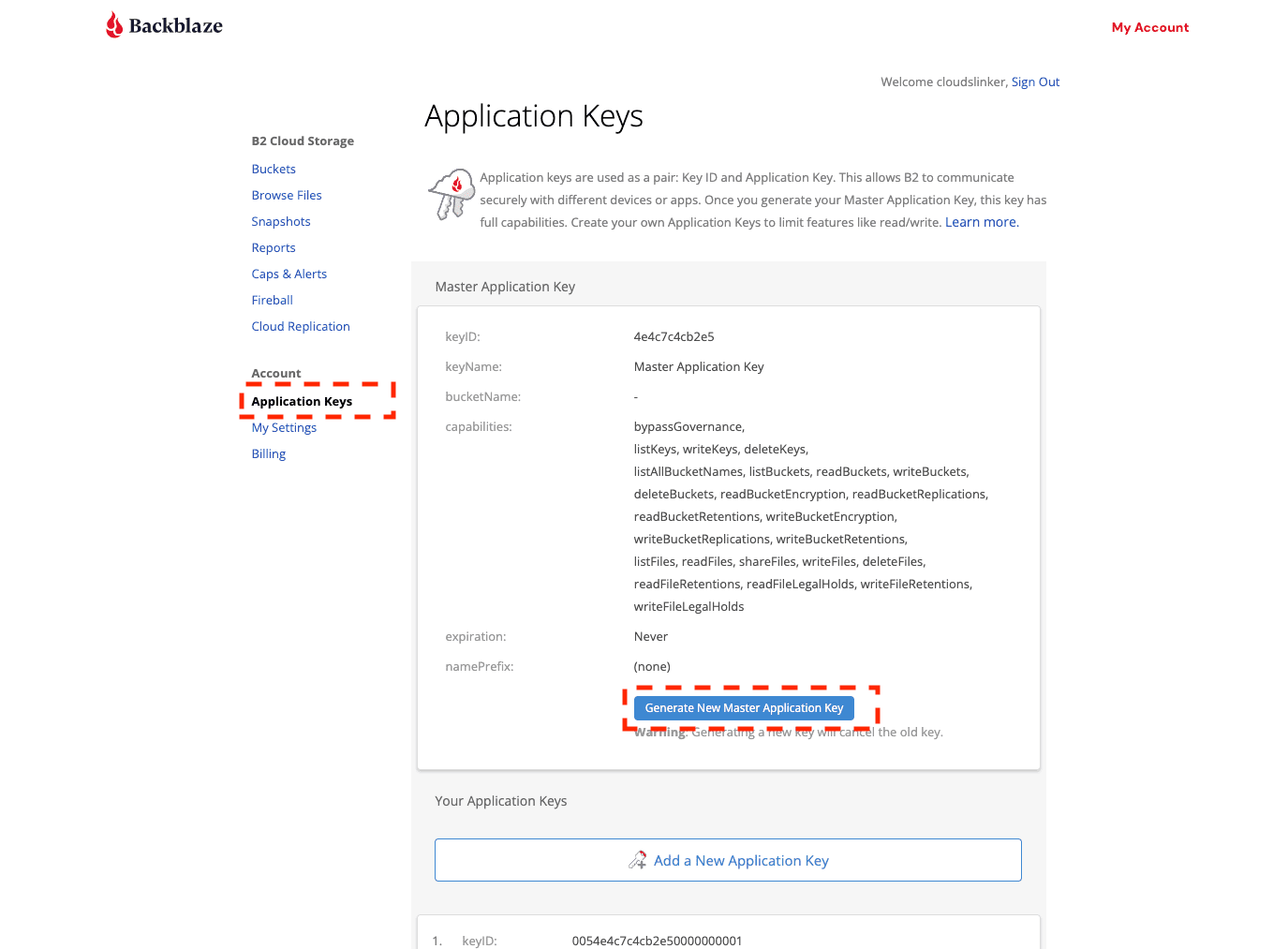
Step 2.2: Copy Endpoint
Backblaze B2 uses region-specific endpoints. For example, use https://s3.us-west-000.backblazeb2.com.
Step 2.3: Add to CloudsLinker
In CloudsLinker, click “Add Cloud”, select ”B2", and fill in:
- Access Key ID (from B2)
- Secret Access Key (from B2)
- Endpoint:
s3.us-west-000.backblazeb2.com
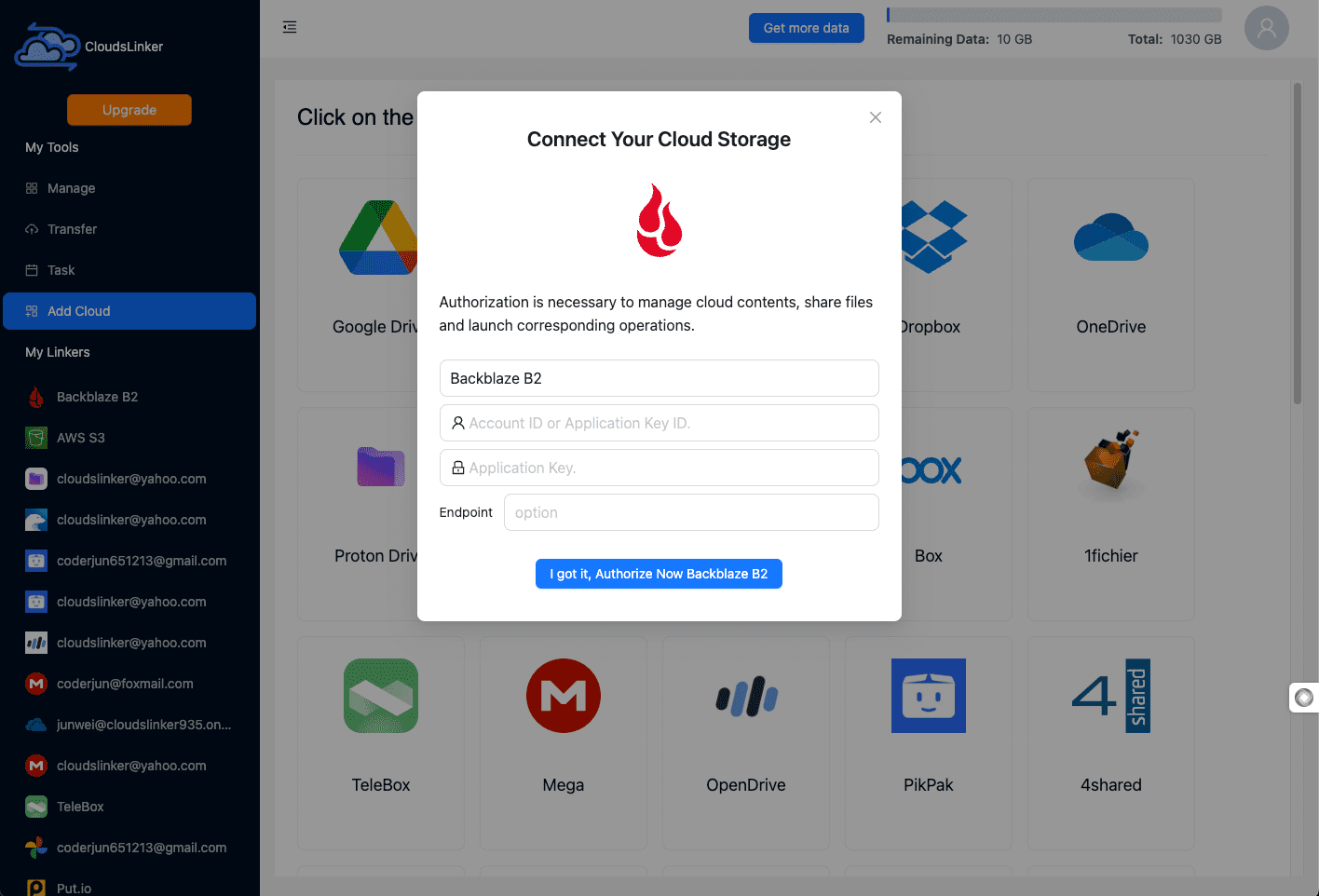
Step 3: Configure Wasabi
Like B2, Wasabi also offers full S3 API compatibility.
Step 3.1: Generate Access Keys
Log into your Wasabi console and generate access keys under the “Access Keys” section.
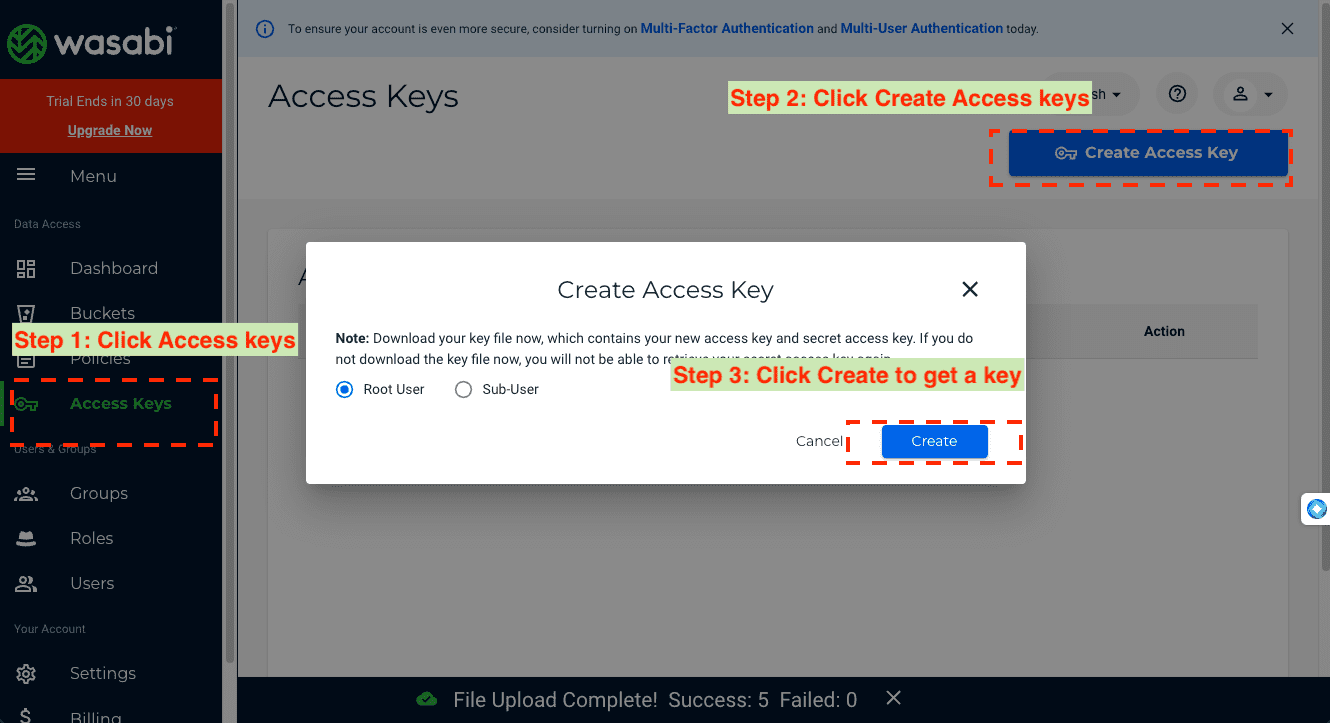
Step 3.2: Determine Region Endpoint
Wasabi has region-based endpoints, such as https://s3.us-east-1.wasabisys.com. Choose the endpoint based on your bucket region.
Step 3.3: Add to CloudsLinker
In CloudsLinker, click “Add Cloud”, select “Wasabi” and enter:
- Access Key ID (from Wasabi)
- Secret Access Key
- Endpoint: e.g.,
s3.us-east-1.wasabisys.com
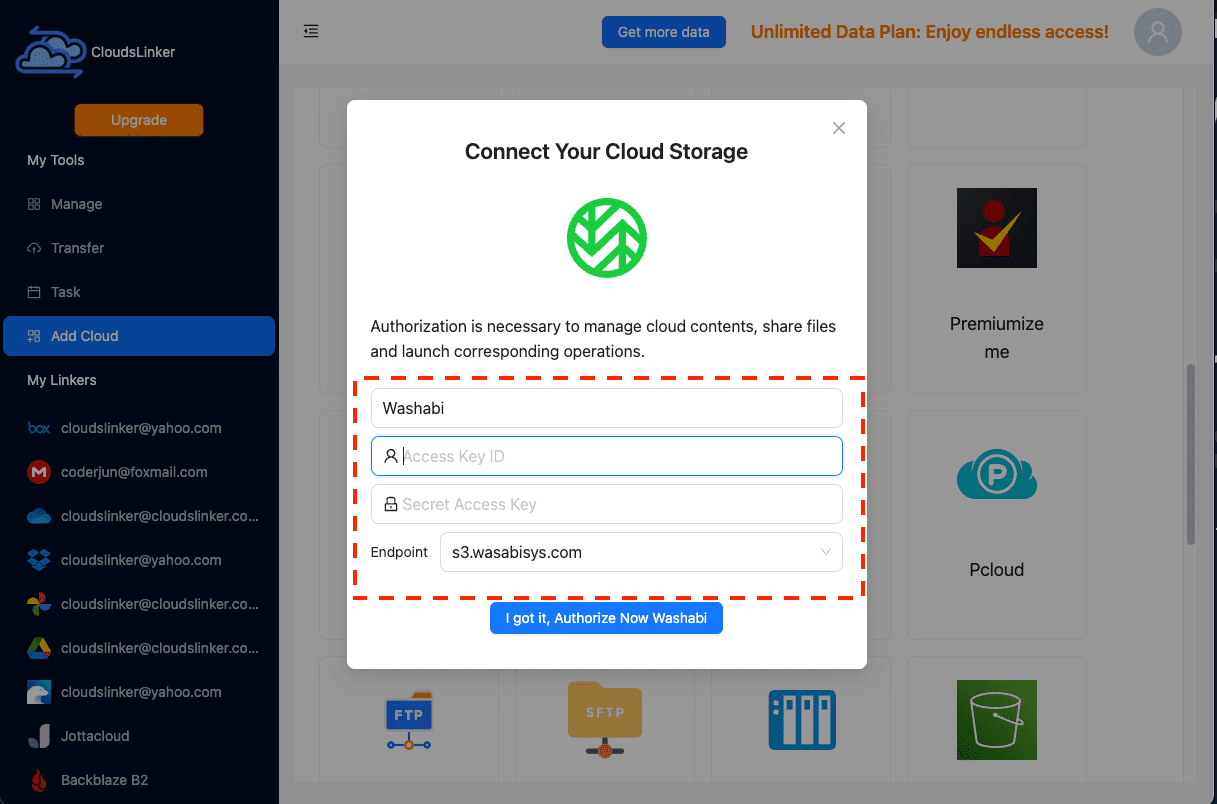
Step 4: Migrate Your Data
Now that both B2 and Wasabi are added, navigate to “Transfer Task” and select:
- Source: Backblaze B2
- Destination: Wasabi
You can choose between “Transfer” or “Sync” modes. In sync mode, the destination will be updated to match the source (including deletions).
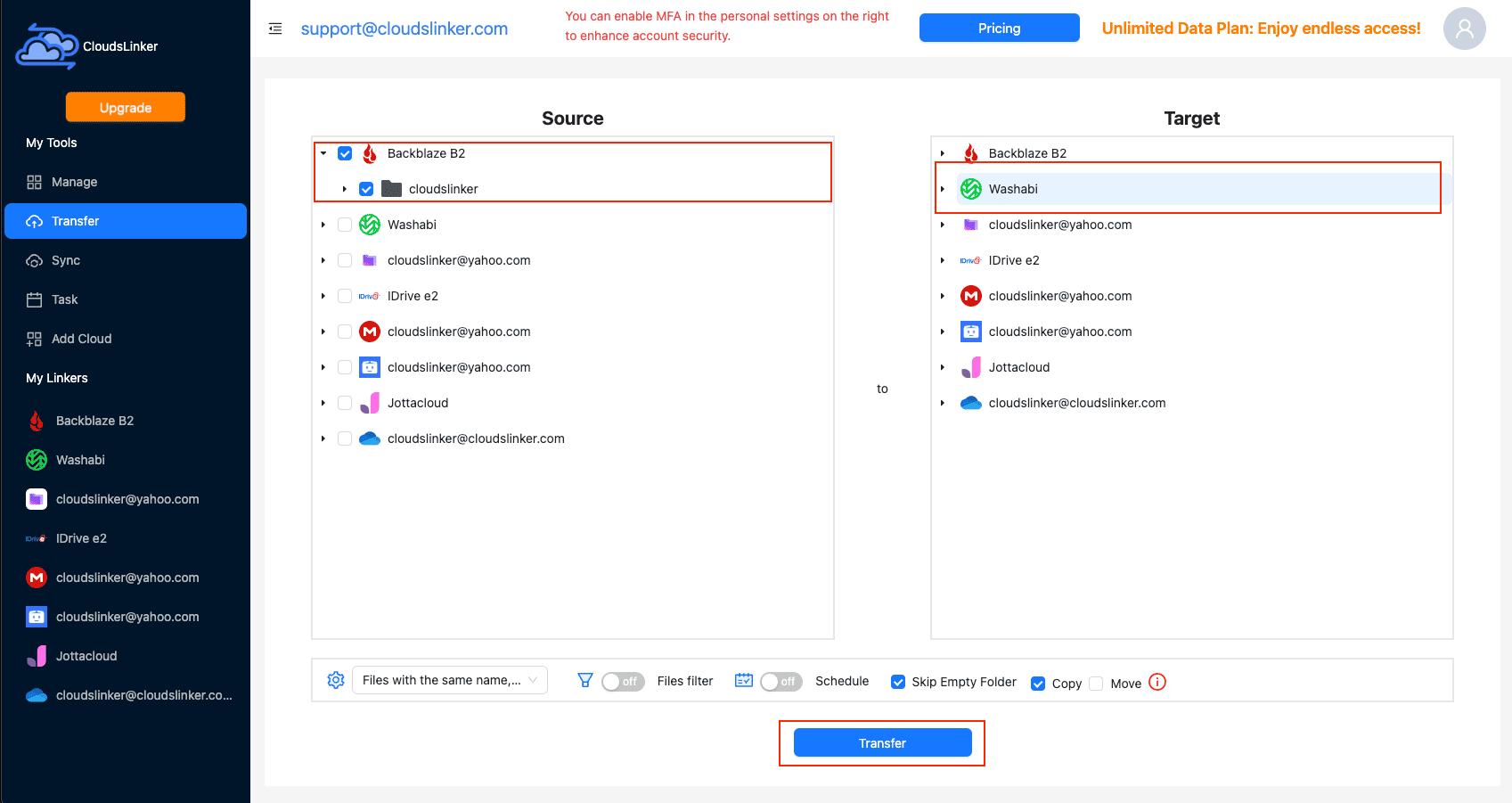
Step 5: Verify and Monitor
Use CloudsLinker’s dashboard to monitor the migration status in real-time. Once complete, verify that files exist in your Wasabi bucket.
Advanced Data Migration: Comparing Python, Rclone, and CloudsLinker
Understanding Migration Options
Migrating data between cloud services like Backblaze B2 and Wasabi can be accomplished using various approaches: command-line tools like Rclone, custom Python scripts, or cloud-based solutions like CloudsLinker. Each has its strengths and ideal use cases.
CloudsLinker: Cloud-Native Advantage
CloudsLinker is a no-code, cloud-based platform that executes all migration tasks remotely, requiring no local storage, system setup, or programming skills. It supports automatic retries, logs, and task scheduling—making it ideal for users looking for simplicity, automation, and performance.
Rclone: Command-Line Control
Rclone is a popular CLI tool favored by system administrators and advanced users. It offers deep control over how files are transferred and synchronized, including granular filters, bandwidth limits, and scripting integration. However, it requires manual setup, server access, and CLI knowledge.
Python: Fully Customizable
A Python-based approach provides the most flexibility, allowing you to build complex logic, event-driven transfers, and integrate with APIs directly. However, it requires programming experience, dependency management, and more maintenance effort.
Comparative Analysis
| Feature | Python Script | Rclone CLI | CloudsLinker |
|---|---|---|---|
| Execution Method | Requires local or cloud VM to run | Runs locally or on server environments | Fully remote, runs on CloudsLinker servers |
| Data Traffic | Consumes local or server bandwidth | Consumes local bandwidth | No local traffic, purely cloud-side transfer |
| Setup Complexity | High – needs coding, keys, libraries | Medium – needs config and S3 credentials | Low – only cloud credentials and endpoint needed |
| Speed | Varies based on network and code | Good, but limited by local I/O | High – optimized via cloud infrastructure |
| Synchronization Support | Manual implementation required | Built-in with sync and filters |
Auto-sync with delete and mirror options |
| Automation & Scheduling | Requires cron or external scheduler | Manual or via cron | Built-in scheduling and task logs |
| Technical Barrier | High – scripting and cloud API knowledge | Medium – CLI and file system knowledge | Low – beginner-friendly UI |
In summary, CloudsLinker is ideal for users who prefer ease of use, full automation, and no reliance on local resources. Rclone is a great middle ground for tech-savvy users who want flexibility without code. Python scripting is best for those needing custom logic and API-level control in enterprise or developer-driven environments.
Frequently Asked Questions (FAQs)
- Backblaze B2:
s3.us-west-000.backblazeb2.com - Wasabi:
s3.us-west-1.wasabisys.com(or your bucket’s actual region)
- Incorrect access keys or endpoint URLs
- API rate limits on Backblaze B2 or Wasabi
- Special characters in file names not handled by one of the APIs
Conclusion
Selecting between Backblaze B2 and Wasabi ultimately depends on your specific priorities. If you’re looking for low base storage costs, flexible pay-as-you-go pricing, and compatibility with tools like Veeam or Synology, Backblaze B2 is an excellent fit. For users who prioritize simplicity, predictable billing, and zero egress or API request fees—especially in data-heavy workflows—Wasabi offers compelling advantages. When it comes to migration, three practical methods exist: Python scripting offers full customization but demands technical expertise; Rclone strikes a balance with powerful features for command-line users; and CloudsLinker stands out as the easiest, most automated solution, requiring no local resources and supporting direct cloud-to-cloud transfer and sync. By aligning your storage provider with the right migration strategy, you can achieve a seamless, scalable, and cost-efficient cloud infrastructure tailored to your operational needs.
Online Storage Services Supported by CloudsLinker
Transfer data between over 40 cloud services with CloudsLinker
Didn' t find your cloud service? Be free to contact: [email protected]
Further Reading
Effortless FTP connect to google drive: Transfer Files in 3 Easy Ways
Learn More >
Google Photos to OneDrive: 3 Innovative Transfer Strategies
Learn More >
Google Photos to Proton Drive: 3 Effective Transfer Techniques
Learn More >
































